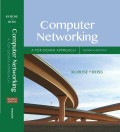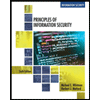
EBK COMPUTER NETWORKING
7th Edition
ISBN: 8220102955479
Author: Ross
Publisher: PEARSON
expand_more
expand_more
format_list_bulleted
Question
Chapter 3, Problem P55P
a)
Program Plan Intro
Given scenario:
A server receives the request and responds a request within UDP packet. If a client with IP address “X” with address “Y”.
b)
Program Plan Intro
Given scenario:
The server receives a “SYN” with IP address “Y” and receives an acknowledgement “ACK” with IP address “Y”.
Expert Solution & Answer
Want to see the full answer?
Check out a sample textbook solution
Students have asked these similar questions
In this problem we investigate whether either UDP or TCP provides a degree of
end-point authentication.
a. Consider a server that receives a request within a UDP packet and responds to
that request within a UDP packet (for example, as done by a DNS server). If a
client with IP address X spoofs its address with address Y, where will the server
send its response?
b. Suppose a server receives a SYN with IP source address Y, and after responding
with a SYNACK, receives an ACK with IP source address Y with the correct
acknowledgment number. Assuming the server chooses a random initial sequence
number and there is no "man-in-the-middle," can the server be certain that the
client is indeed at Y (and not at some other address X that is spoofing Y)?
Using a TCP SYN spoofing attack, the attacker aims to flood the table of TCP connection requests on a system so that it is unable to respond to legitimate connection requests. Consider a server system with a table for 256 connection requests. This system will retry sending the SYN-ACK packet five times when it fails to receive an ACK packet in response, at 30 second intervals, before purging the request from its table. Assume that no additional countermeasures are used against this attack and that the attacker has filled this table with an initial flood of connection requests.
a. At what rate must the attacker continue to send TCP connection requests to this system in order to ensure that the table remains full?
b. Assuming that the TCP SYN packet is 40 bytes in size (ignoring framing overhead), how much bandwidth does the attacker consume to continue this attack?
Consider a simple UDP-based protocol for requesting files (based
somewhat loosely on the Trivial File Transport Protocol, or TFTP).
The client sends an initial file request, and the server answers (if
the file can be sent) with the first data packet. Client and server
then continue with a stop-and-wait transmission mechanism.
(a) Describe a scenario by which a client might request one file
but get another; you may allow the client application to exit
abruptly and be restarted with the same port.
(b) Propose a change in the protocol that will make this situation
much less likely.
Chapter 3 Solutions
EBK COMPUTER NETWORKING
Ch. 3 - Prob. R1RQCh. 3 - Prob. R2RQCh. 3 - Consider a TCP connection between Host A and Host...Ch. 3 - Prob. R4RQCh. 3 - Prob. R5RQCh. 3 - Prob. R6RQCh. 3 - Suppose a process in Host C has a UDP socket with...Ch. 3 - Prob. R8RQCh. 3 - Prob. R9RQCh. 3 - In our rdt protocols, why did we need to introduce...
Ch. 3 - Prob. R11RQCh. 3 - Prob. R12RQCh. 3 - Prob. R13RQCh. 3 - Prob. R14RQCh. 3 - Suppose Host A sends two TCP segments back to back...Ch. 3 - Prob. R16RQCh. 3 - Prob. R17RQCh. 3 - Prob. R18RQCh. 3 - Prob. R19RQCh. 3 - Prob. P1PCh. 3 - Prob. P2PCh. 3 - UDP and TCP use 1s complement for their checksums....Ch. 3 - Prob. P4PCh. 3 - Prob. P5PCh. 3 - Prob. P6PCh. 3 - Prob. P7PCh. 3 - Prob. P8PCh. 3 - Prob. P9PCh. 3 - Prob. P10PCh. 3 - Prob. P11PCh. 3 - Prob. P12PCh. 3 - Prob. P13PCh. 3 - Prob. P14PCh. 3 - Prob. P15PCh. 3 - Prob. P16PCh. 3 - Prob. P17PCh. 3 - Prob. P21PCh. 3 - Prob. P22PCh. 3 - Prob. P25PCh. 3 - Prob. P26PCh. 3 - Prob. P27PCh. 3 - Host A and B are directly connected with a 100...Ch. 3 - Prob. P29PCh. 3 - Prob. P30PCh. 3 - Prob. P31PCh. 3 - Prob. P33PCh. 3 - Prob. P34PCh. 3 - Prob. P35PCh. 3 - Prob. P37PCh. 3 - Prob. P38PCh. 3 - Prob. P39PCh. 3 - Prob. P41PCh. 3 - Prob. P42PCh. 3 - Prob. P43PCh. 3 - Prob. P44PCh. 3 - Prob. P45PCh. 3 - Prob. P46PCh. 3 - Prob. P47PCh. 3 - Prob. P48PCh. 3 - Prob. P49PCh. 3 - Prob. P51PCh. 3 - Prob. P53PCh. 3 - Prob. P55P
Knowledge Booster
Similar questions
- We explore whether either UDP or TCP offers any level of end-point authentication in this problem. a. Consider a server that accepts a request via UDP and responds via UDP (for example, as done by a DNS server). Where would the server give its answer if a client with IP address X spoofs it with address Y? b. Assume a server receives a SYN with IP source address Y and responds with SYNACK. The server then receives an ACK with IP source address Y and the right . acknowledgment amount. Assuming the server selects a random initial sequence number and there is no "man-in-the-middle," how can the server be confident that the recipient is really at Y (and not at any other address X that spoofs Y)?arrow_forwardWe explore whether either UDP or TCP offers any level of end-point authentication in this problem. a. Consider a server that accepts a request via UDP and responds via UDP (for example, as done by a DNS server). Where would the server give its answer if a client with IP address X spoofs it with address Y? b. Assume a server receives a SYN with IP source address Y and responds with SYNACK. The server then receives an ACK with IP source address Y and the right acknowledgmentamount. Assuming the server selects a random initial sequence number and there is no "man-in-the-middle," how can the server be confident that the recipient is really at Y (and not at any other address X that spoofs Y)?arrow_forwardTCP sessions are full-duplex, which means that data can be sent in either direction during the lifetime of the session. Consider a session in which the connection is established, the client sends 100 data segments, all of them are ACKed, and all of the ACKS are received by the sender, then the session is ended by both sides closing the connect. How many segments in total have the SYN bit of the header set to 1? а. 4 O b. 2 с. O d. 1 е. 209arrow_forward
- Consider a TCP session between Hosts A and B. Assuming that Host A sends a 10byte segment with sequence number 5, what will be the sequence number of the acknowledgment sent from B to Aarrow_forwardDNS makes use of UDP rather than TCP. If a DNS packet is dropped, there is no way to recover automatically. Is this a problem, and if so, how does one go about resolving it?arrow_forwardThree-way handshake is used by a TCP client and a TCP server to establish a connection, as illustrated below: 1st: client:port1 -> server:port2, SYN 2nd: server:port2 -> client:port1, SYNACK 3rd: client:port1 -> server:port2, ACK When this client is performing scanning attacks, it will generated a large number of failed connections. In each failed connection, the three-way handshake fails to complete. People commonly use SYN together with the absence of its corresponding SYNACK in this same TCP session to identify whether this connection is failed. By investigating the failed connections, an engineer finds that in legitimate/benign cases, if the server does not return SYNACK to the client, the client will not send the ACK packet after SYNACK (e.g., the 3rd packet above). Therefore, this engineer suggests that we can count the failed connections based on the following rules without considering SYNACK:arrow_forward
- TCP sessions are full-duplex, which means that data can be sent in either direction during the lifetime of the session. Consider a session in which the connection is established, the client sends 100 data segments, all of them are ACKed, and all of the ACKS are received by the sender, then the session is ended by both sides closing the connect. How many segments in total have the SYN bit of the header set to 1? а. 209 O b. 2 6 с. d. 4 О е. 1arrow_forwardConsider a client connecting to a web server via a router as shown in Fig.Q2. Client A sends a request to the server to retrieve a 7.5 Mbytes file. Given that the segment size is 50 Kbytes, the round trip time (RTT) between the server and client is 10 ms, the initial slow-start threshold is 16 and the client's buffer always has a storage space of 1 Mbytes. Assume that TCP Reno is used, there is no loss during transmission and the headers of protocols are ignored. 400 Mbps 200 Mbps 400 Mbps Link a Link b Link c Client Web Server Fig.Q2 (a) Describe how the value of sending window changes as a function of time (in units of RTT) during the whole connection time. 2.arrow_forwardThree-way handshake is used by a TCP client and a TCP server to establish a connection, as illustrated below: 1st: client:port1 -> server:port2, SYN 2nd: server:port2 -> client:port1, SYNACK 3rd: client:port1 -> server:port2, ACK When this client is performing scanning attacks, it will generated a large number of failed connections. In each failed connection, the three-way handshake fails to complete. People commonly use SYN together with the absence of its corresponding SYNACK in this same TCP session to identify whether this connection is failed. By investigating the failed connections, an engineer finds that in legitimate/benign cases, if the server does not return SYNACK to the client, the client will not send the ACK packet after SYNACK (e.g., the 3rd packet above). Therefore, this engineer suggests that we can count the failed connections based on the following rules without considering SYNACK: If a client:port1 sends…arrow_forward
- Suppose a firewall is configured to allow outbound TCP connections but inbound connections only to specified ports. The FTP protocol now presents a problem: When an inside client contacts an outside server, the outbound TCP control connection can be opened normally but the TCP data connection traditionally is inbound. (a) Look up the FTP protocol in, for example, Request for Comments 959. Find out how the PORT command works. Discuss how the client might be written so as to limit the number of ports to which the firewall must grant inbound access. Can the number of such ports be limited to one? (b) Find out how the FTP PASV command can be used to solve this firewall problem.arrow_forwardConsider an HTTP server and client as shown in the figure below. Suppose that the RTT delay between the client and server is 13 msecs; the time a server needs to transmit an object into its outgoing link is 1 msecs. Any other HTTP message not containing an object has a negligible (zero) transmission time. Suppose the client again makes 106 requests, one after the other, waiting for a reply to a request before sending the next request. Assume the client is using HTTP 1.1 and the IF-MODIFIED-SINCE header line. Assume 47% of the objects requested have NOT changed since the client downloaded them (before these 106 downloads are performed). Clients RTT delay: t Transmission delay: ta Intemet APACHE Server How much time elapses (in milliseconds) between the client transmitting the first request, and the completion of the last request?arrow_forwardIn IEEE 802.11, two-way communication is used to authenticate an open system. In order to authenticate the client, the server must give the station ID (typically the MAC address). Response to the client's previous request is either a successful or failed authentication response from the access point/router. An error may arise if, for example, an AP/router configuration does not include the client's MAC address.In what ways is it advantageous to use this kind of authentication scheme?In what ways does this authentication technique have security vulnerabilities that might be mitigated?arrow_forward
arrow_back_ios
SEE MORE QUESTIONS
arrow_forward_ios
Recommended textbooks for you
 A+ Guide To It Technical SupportComputer ScienceISBN:9780357108291Author:ANDREWS, Jean.Publisher:Cengage,
A+ Guide To It Technical SupportComputer ScienceISBN:9780357108291Author:ANDREWS, Jean.Publisher:Cengage, Principles of Information Security (MindTap Cours...Computer ScienceISBN:9781337102063Author:Michael E. Whitman, Herbert J. MattordPublisher:Cengage Learning
Principles of Information Security (MindTap Cours...Computer ScienceISBN:9781337102063Author:Michael E. Whitman, Herbert J. MattordPublisher:Cengage Learning

A+ Guide To It Technical Support
Computer Science
ISBN:9780357108291
Author:ANDREWS, Jean.
Publisher:Cengage,

Principles of Information Security (MindTap Cours...
Computer Science
ISBN:9781337102063
Author:Michael E. Whitman, Herbert J. Mattord
Publisher:Cengage Learning